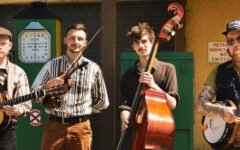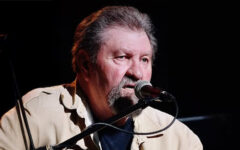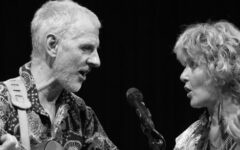
With their wide-brimmed hats, suspenders, string ties and long black coats Canada’s The Dead South look like a cross between old country Quakers and the last gunfighters to survive the shootout at the OK Corral. It’s an image that’s worked well for them, bringing the band — Nate Hilts (vocals, guitar, mandolin), Scott Pringle (guitar, mandolin, vocals), Danny Kenyon (cello, vocals), and Colton Crawford (banjo) — a pair of Juno Awards for Traditional Album of the Year.
The band’s latest releases consists of a pair of EPs title Easy Listening for Jerks, Parts 1 and 2. They feature an array of (mostly) vintage country covers as well as some more modern contemporary songs that wouldn’t be considered part of a traditional template. The fact that they make reference to ‘jerks’ suggests a certain disdain, and indeed, though they may be cozying up the classics, they take an irreverent attitude that casts the usual archival influences to the wind.
Those who are unfamiliar with The Dead South’s MO may find themselves easily enticed by the band’s reverence for their roots as well as their arched insurgency. In order to get the backstory on this decidedly distinct outfit, we spoke with Colton Crawford who was only too happy to offer some explanation.
For starters, please tell us how you met. What were your goals and intentions early on?
I met Nate through some mutual friends in University. We had absolutely zero goals as far our musical direction or career — we just started playing music together and playing local shows. I had just started to learn the banjo and Nate [Hilts] had just started to write songs and sing, so a lot of the early songs were just things we had come up with when we were learning how to play and write songs. We still don’t really write with any type of intention — we just play with ideas and see what excites us.
Who were your early influences?
Early on we listened to a lot of the “bluegrass revival” bands. Mumford and Sons were at the height of their fame, Trampled by Turtles, Old Crow Medicine Show, and The Devil Makes Three were all huge bands for us. We all grew up on punk and metal and classic rock as well, so I think we subconsciously bring a lot of that to the table, especially in terms of how we structure songs. We have a “verse/chorus/verse/chorus/breakdown” structure similar to rock and pop music, as opposed to a more traditional bluegrass structure.
And what does the name Dead South come from?
Honestly, nothing at all really. We had a drummer in the early days of the band who came up with the name “The Dead Souths,” but it was awkward to say with the “s” at the end of “souths,” so we dropped the “s” and became The Dead South. We had our first show booked and needed the name, so we went with that and it stuck. It seemed to fit the musical style as well, so we just went with it.
Where do you get your inspiration these days?
It depends what you mean by inspiration, but musically we are inspired by artists mentioned above. I listen to a lot of metal music, so that’s my main musical influence and inspiration.
Do you ever find it difficult to tow the line between the traditional sounds of bluegrass and your individual approach? In that regard, have you ever gotten negative feedback from the traditionalists?
We’ve gotten a little bit of negative feedback but not too much honestly. There are traditionalists in every genre, and bluegrass certainly has its purists, but by and large we’ve been treated quite well by the bluegrass community.
How did the new double EP come about? And why did you decided to do two EPs as opposed to a single LP?
Over COVID, our publishing company (Peer Music) approached us to make a bunch of traditional folk and bluegrass recordings. Once we had recorded a few of the songs, we thought, “We may as well release these.” We were originally going to record ten or so traditional songs, but then we thought that this would be the perfect opportunity to record some of the rock songs we’d been wanting to cover forever (Chop Suey, 96 Quite Bitter Beings, etc.), so we decided to do two separate EPs, with one focusing on the traditional songs. It also seemed like a great way to introduce people to new music, and to showcase the two sides of who we are — kids raised on punk and rock and metal, who now play folk and bluegrass.
So what motivated you to name the album Easy Listening for Jerks? That can be construed in a negative way, no?
Nate came up with that name a long time ago and I loved it for some reason. It also hints at the two sides of who we are as a band like I was talking about earlier — some songs are nice folksy songs with tender lyrics, and some are more aggressive punk songs, played hard on acoustic instruments with bizarro crazy lyrics. The title hits the juxtaposition of those two sides very well I think.
How did you choose the covers? The Doors cover seems somewhat out of sync — what promoted you to include that?
For part 2, we had two songs we had wanted to cover as a band for a long time — 96 Quite Bitter Beings and Chop Suey — and we each chose one additional song to cover. I chose Help Me Scrape the Mucus Off My Brain by Ween, Nate chose Saturday Night by the Misfits, Danny chose We Used To Vacation by Cold War Kids, and Scott chose People are Strange.
Finally, why do you think bluegrass enjoys such international popularity?
I think there is something about acoustic instruments that makes it an easy genre for people to listen to, regardless of age and musical preference. We have lots of older bluegrass fans, and we have lots of younger metal fans who listen to our music as well. I think it would be similar for a lot of the other bands in our genre working today. Metal and punk are an acquired taste, but if you play similar songs on acoustic instruments, people who wouldn’t normally listen to those genres can find something they enjoy.







